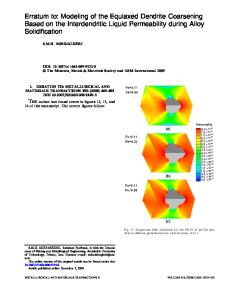Modeling of the Equiaxed Dendrite Coarsening Based on the Interdendritic Liquid Permeability during Alloy Solidification
- PDF / 1,114,286 Bytes
- 15 Pages / 593.972 x 792 pts Page_size
- 88 Downloads / 372 Views
permeability of interdendritic liquid flow through dendritic structures is an important parameter, and it is vital to predict the level of porosity during casting operations. Fluid flow in dendritic structures is responsible for most macrosegregation and porosity in castings and ingots. In fact, the pressure drop due to shrinkage and restricted feeding through dendritic structures is a major factor contributing to the formation of microporosities in the cast parts. An effective permeability may give usable results when the length scale under consideration is sufficiently greater than the microstructural length scale. This effective permeability depends on the detailed flow pattern at the microscale, which in turn depends on the shape and nature of the channels through which the liquid flows. In the dendritic mushy zone, these shapes are quite complex, while measurement of the exact flow patterns is very difficult. The micro fluid flow in the mushy zone could be modeled based on Darcy’s law.[1] The permeability is a component of Darcy’s law, used to estimate the pressure drop within dendritic structures. Therefore, a broad range of work has been focused on measuring and calculating the permeability of liquid in the mushy zone. These investigations could be divided into two main categories: mathematical models and experimental methods. There are two commonly analytical models for calculating nondimensional permeability for creep S.M.H. MIRBAGHERI, Assistant Professor, is with the Department of Mining and Metallurgical Engineering, Amirkabir University of Technology, Tehran, Iran. Contact e-mail: smhmirbagheri@aut. ac.ir Manuscript submitted May 31, 2007. Article published online May 30, 2008. METALLURGICAL AND MATERIALS TRANSACTIONS B
flow through periodic or random arrays of cylinders having simple cross sections such as circular or hexagonal forms. A few researchers have analyzed the governing equations employing lubrication and dilute models.[2,3] The first model, called the lubrication model, developed by Bruschke and Advani,[2] is applicable for high solid-fraction arrays, while the second one, developed by Gebart,[3] is mainly employed in low solid fraction arrays. However, so far the analytical approaches are not applicable in the modeling of dendrite structures in the casting of samples with complex shapes. Under these conditions, numerical methods have been used to model micro fluid flow in dendritic structures.[4–9] Many researchers have calculated the permeability based on a numerical solution of Navier–Stokes (N-S) equations in a domain representing the geometry of the interdendritic liquid. During the 1990s, several authors[10–14] used this approach to calculate the permeability in two-dimensional columnar and equiaxed dendrite skeletons. Diepers et al.[15] have studied the effect of convection on the coarsening and the permeability in Al-4 wt pct Cu using a phase field formulation. Brown et al.[16] calculated permeability in an AlSiCu alloy with an equiaxed dendritic microstructure. In another work, the geometry of the int
Data Loading...










